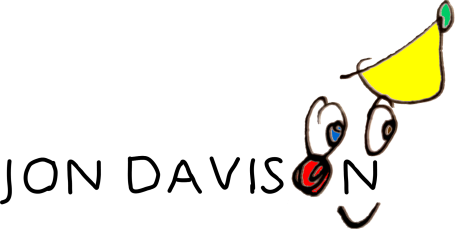
Clown Theory
How useful are the main theories about how clowning works and what it means?
The circus clown died in the 50s. A victim of our distrust of the tyranny of tradition. Lecoq's contemporary personal clown, born of the 60s, sustained itself for half a century on our obsession with self. Now, in the 21st century, our inner self is no more, we are all public knowledge in a globalised, viralised world where anyone or anything can be clown - man, woman, child, cat, dog... No need to look inside. All it takes is the right framing.
Once one had to be born into the right family, the clown aristocracy whose preordained destiny one passed on. Later, one must make one's own choice, an existential act of liberty and self-definition. What does it take now, in the 21st century, to be clown?
I had been interested in these problems for many years leading up to when I did my PhD at CSSD in 2012-2016.
'The Self-Deconstruction of Clowning'
(PhD Thesis 2016, University of London)
full text available here

Clown Truth: can clown performance be made out of clown training?
A performance/demonstration/lecture
This performance emerged from a desire to confuse the conventions found in, on the one hand, clown performance and, on the other, clown workshops. The ‘contract’ between participants and teacher appears to differ so widely from the ‘contract’ between performer and audience, that what happens in one may never happen in the other.
I wanted to find a way to introduce, into a conventional performance setting, some frequently occurring elements of clowning workshops (principally, the famous ‘flop’), often witnessed and performed by those signed up to the workshop experience; elements which rarely, if ever, in my observation, find their way into public clown performance.
In this performance/demonstration, by means of ostensibly explaining and presenting how I teach clowning, I aim also to problematise the orthodox notions about how we should interpret these manifestations of clowning. Since Lecoq in the early 1960s, the discourse of the inner clown or the authentic self/clown, revealed by the removal of social masks, has held sway. In this performance I hope to show how this discourse stumbles under the pressure of clowning itself, and suggest that clowning does not reveal pre-existent selves, but instead produces, by dramaturgical means, a staged clown persona. The clown is thus an illusion, but no less pleasurable for being non-authentic. Indeed, I hope to show how the greatest pleasures are to be had in this very realisation, that the spectator’s (and clown performer’s) feelings of being in the presence of ‘the clown’ is contradicted by the evidence, that there is no inner clown. In other words, the best joke is that it’s all theatrical.

Science proves that the personal clown
does not exist
The scientific method, reliant upon experiments which fail and thereby produce new hypotheses, is a natural companion for clown research, where failure witnessed by others equals success.
My demonstration of a failed experiment clearly shows that my mother's claim that plants thrive on tea is a myth. On the other hand, my potted plant which failed to grow did raise a laugh, thus successfully repeating Jacques Lecoq's 1960s experiment with the flop, where he showed that we laugh when you admit you've failed. However, it did not corroborate Lecoq's interpretation of the data of his experiment: it proved impossible for me to convince my audience that my dead plant was funny because it had an inner clown self which was more authentic than its social masks.
This experiment thus marks the end of the myth of the personal clown.
Clowns frequently claim to access authenticity by unmasking social conventions or exposing the workings of performance genres, thus presuming power within society as taboo-breakers and truth-tellers.
Contemporary clown’s version of this tale stresses the dynamics of the ‘flop’ as the gateway to such truth. The performer, admitting failure to convince the audience of his/her competence, seems thereby to reveal a reality behind the mask of convention. By owning one’s flops, one is identified with ‘truth’, since to make a mistake must, by definition, be unintentional (i.e. they escape manipulation).
However, the professionalisation of clowning indicates that this unintentionality is in fact willed, practised and skilled. The ‘flop’ is an ‘authenticity-effect’ which stages ‘reality’. Given that clowns habitually admit to conventions, how might one declare this particular ‘truth-trick’?
Would such a ‘deconstructed clowning’ still seem like clowning and give the same pleasure as that staging of the authentic which clowns presume to do?
This is a three-year PhD practice-as-research project at Central School of Speech and Drama (2012-15), looking at the gaps between clown theory and clown practice. In other words, the difference between what we like to say about clowning and what we actually do when we clown.
It begins by examining some dominant practices in contemporary clowning, focusing on two performance strategies or techniques available to the clown performer today: the performer’s flop, or failure; and the audience’s laughter response. Both the flop and laughter are identified by some as necessary elements in defining the dynamics of clowning, although some clown practitioners dispute this.
I examine how both these principles hold privileged positions within my own performance work. Through the devising of performance pieces specifically founded on these ‘clown principles’ I aim to test the functioning of these principles and the limits of such an approach.
These strategies have been dominant in clown training over several decades, but arguably have been used far less in actual clown performance. In what way does failure ‘work’? When does failure fail?
The Deconstruction of Clowning - conception, devising, rehearsal, direction and performance.
The video clips represent some key moments in the process of practice-as-research as I understand it.


How to do William Tell
On the undecideability of spontaneity...
Transcript and video clips of opening 12 minutes of a presentation of my research, to MA students at CSSD in January 2013.

Clip I: “The Joke”
I was going to start with a joke, but I won’t. But I’ll tell you what it was. I was going to say, ‘So, any questions?’ (very delayed audience laughter). But I thought it won’t be funny so I won’t use it. So, I was right. (aud. laughs) However, me telling you about the joke.. wasn’t that funny was it? No, but then, when I said, ‘it wasn’t funny, therefore I was right’, that was funny. You following me? I wasn’t going to start like this. So here was the joke, there was me telling you I wasn’t going to do it, here was me telling you – which you knew – it wasn’t that funny, then there’s me... oh, which you found funny... I can’t remember it now. Then ... etc. etc... you remember? Right. No.

Clip II: “The Script”
So, here’s another thing. Script. (I show them my printed notes) Script for today, page one of nineteen. We’re going ok, timewise. But I haven’ started it yet. Well, I have a script. Have I used the script yet? Do you know if I’ve used the script yet? You don’t know? Or you think I haven’t? We don’t know. You don’t know. It feels like a routine is going on, though. Yes, a routine is going on. I’ve told you, I didn’t plan to do it this way, do you believe me? No! No, why not? It’s too polished. Too polished? Thank you very much. The absolute truth is that I didn’t plan to do it this way. (Audience laughs) However, I haven’t yet started with the script. However, there is a script. I did prepare and the things I am doing now, although they are unique because they are being done now, I have done them before in some form or another. Not in that order...

Clip III: “Spontaneity”
So, now I have to remember again, where I was going. Ah yes, you did think it was a polished performance, you didn’t believe it was spontaneous. How would you know it was spontaneous, how would you recognise spontaneity if it was there in front of you? (Audience:) ‘By failure?’
By failure, but I failed and you still thought it was prepared.
(Audience:) ‘The blush response.’
Have I blushed so far?
(Audience) ‘No’...
I have! But you didn’t see it. Because I turned this way. But yes, the blush, meaning an uncontrollable response which is not possible to produce at will.
(Audience:) ‘Your breathing. You exhaled like this, and you inhaled sometimes like this. It showed to me that you had a kind of stress.’
Yes! I had a certain amount of stress. I am trying to present to you a combination of how I research, how it might be useful to you, how I perform because that’s part of what I do as a researcher. So I’m moving, it’s a hybrid between performing, lecturing, questions and answers, teaching... yes, like that (I breathe out tensely). Does that tell you it’s spontaneous or not? So, my ability to...because what you’re saying there is that this stress is perhaps something we want to eliminate from an actor’s training. But maybe it’s a marker of spontaneity? Interesting point. Ok, let’s go on to the script.
(12’23”)
